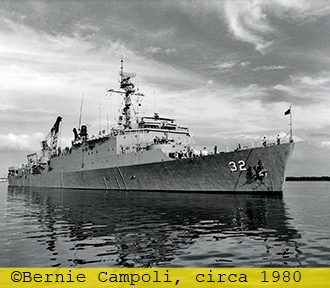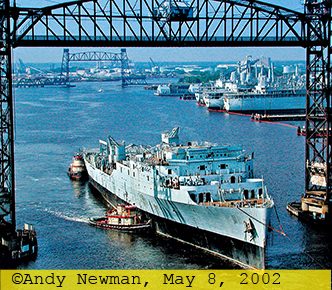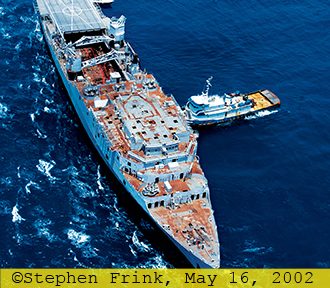The 20th Anniversary of an Ambitious Achievement










THE LONG, STRANGE TRIP OF THE Spiegel Grove began in 2001 over beers at Sharkey’s Bar in Key Largo, Florida. Several Bibb and Duane shipwrecks project organizers were musing about what they would do differently next time. They had successfully sunk the pair of 327-foot Coast Guard cutters as artificial reefs in 1987, but all agreed that the next ship should be bigger.
Former Key Largo National Marine Sanctuary manager Bill Harrigan said plenty of large, derelict vessels were in the Navy’s mothball fleet along the James River in Virginia. He went to look for us, and I remember the day he called to say he’d located one. “I found it, Steve. Five hundred and ten feet long, lots of decks and doors and companionways to swim through. Giant well dock at the stern that will probably hold schooling fish. All we gotta do is get it donated, clean it, tow it, and sink it.” Yeah, Bill — that’s all.
“… All we gotta do is get it donated, clean it, tow it, and sink it.”
For the 20th anniversary of sinking the Spiegel Grove, this photo retrospective shows its evolution from a former Navy vessel to a complete reef ecosystem.
Launched in 1955 and decommissioned in 1989, the ship was named for former President Rutherford B. Hayes’ estate and sailed with 18 officers and 330 enlisted crew. The Navy donated it to the Key Largo Chamber of Commerce, which worked with the Upper Keys Artificial Reef Association to clean contaminants and mitigate the predictable hazards to divers. Primary funding for the project came from the Monroe County Tourist Development Council.
It was quite an ordeal to get the Spiegel Grove cleaned and get both the Coast Guard and the Environmental Protection Agency to agree it was ready to be sunk in the Florida Keys National Marine Sanctuary (FKNMS) waters. A rigorous underwater survey ensured the site would not damage any natural coral reef, and it had to be deep enough to never be a hazard to ships passing overhead. The project eventually surpassed the original budget, so several Key Largo dive operators had to sign promissory notes with local banks to fund finishing the preparation. They recouped the money by selling dive medallions to tourists who wanted to dive the local artificial reefs.
Once the ship anchored on location off Dixie Shoal, 6 miles offshore from Key Largo, there was still work to do. Local volunteers did last-minute cleaning and welded open or removed doors that might later prove hazardous to divers. Boats shuttled crews of workers to the site for a week’s worth of preparations necessary to get final Coast Guard authorization to sink the Spiegel Grove.
Because of the FKNMS waters’ ecological sensitivity, it was never possible to sink the vessel with controlled explosives, which risked killing fish or marine mammals in the area. Instead, water pumped into the ship would intentionally scuttle it. It’s possible that some of the watertight bulkheads gave way and flooded the engine room, but whatever the cause, the ship rapidly took on water while the bow was still trapping air, and it turned turtle. The stern rested on the seafloor when the day was over, and the bow was still above the surface. May 17, 2022, was the official 20th anniversary of the sinking, such as it was that day.
Over the years the wreck has acquired an impressive patina of sponges and deep-water gorgonians. According to a Reef Environmental Education Foundation census, it hosts an amazing variety of marine life — at least 166 tropical fish species.
I recall my first conversation with the Coast Guard after the Spiegel Grove became stuck as something like, “You need to understand something. You don’t have a shipwreck. You have a hazard to navigation. This needs to get fixed, or we’ll arrange to have it blown apart. It is unacceptable like this.” Organizers had already committed $1 million to sink the ship, but now there was more to be done. Another $250,000 was added to the budget for Resolve Marine Group to find a way to put the Spiegel Grove on the seafloor. They worked with a task force of local volunteers for three weeks to deploy massive lift bags. The idea was that if tugboats pulled while the bags lifted, the ship might roll over and land upright on the bottom. On June 10, 2002, the ship finally sank, but not upright — it came to rest on its starboard side.
The Spiegel Grove rested that way for three years but was still an immensely successful shipwreck. Estimated figures suggest up to 50,000 divers per year visited the wreck in that time.
On July 9, 2005, Hurricane Dennis swept along Florida’s Gulf Coast, generating massive waves. The storm passed about 125 miles to the west of Key West yet still generated strong winds and storm surge all the way to Key Largo.
The combination of the surge, current, and the shallow trough lying behind the wreck coalesced into the perfect conditions for the Spiegel Grove to roll perfectly upright. Seventeen years later, it remains upright in 134 feet of water, with the top of the wheelhouse around 60 feet deep and the first of the swim-throughs just a bit deeper. Over the years the wreck has acquired an impressive patina of sponges and deep-water gorgonians. According to a Reef Environmental Education Foundation census, it hosts an amazing variety of marine life — at least 166 tropical fish species.
The Spiegel Grove started with ambition, sank into complications, and emerged as one of the most popular wreck dives in the Florida Keys.
Explore More
Dive the Spiegel Grove in this video.
© Alert Diver — Q2 2022